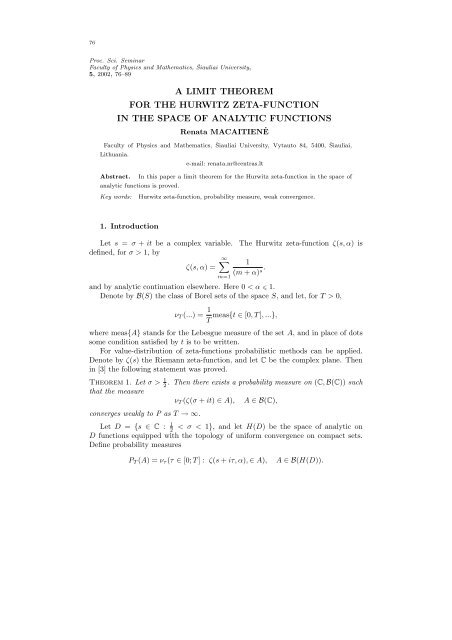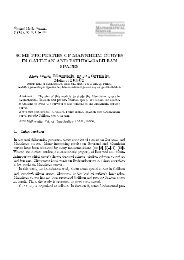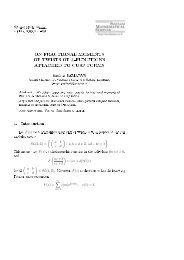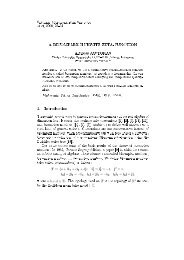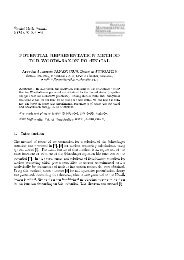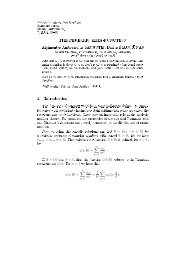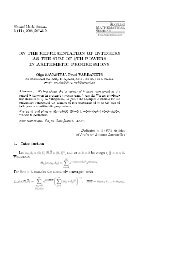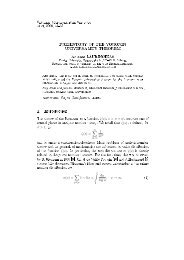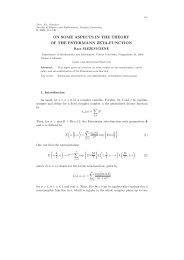a limit theorem for the hurwitz zeta-function in the space of analytic ...
a limit theorem for the hurwitz zeta-function in the space of analytic ...
a limit theorem for the hurwitz zeta-function in the space of analytic ...
You also want an ePaper? Increase the reach of your titles
YUMPU automatically turns print PDFs into web optimized ePapers that Google loves.
76<br />
Proc. Sci. Sem<strong>in</strong>ar<br />
Faculty <strong>of</strong> Physics and Ma<strong>the</strong>matics, Šiauliai University,<br />
5, 2002, 76–89<br />
A LIMIT THEOREM<br />
FOR THE HURWITZ ZETA-FUNCTION<br />
IN THE SPACE OF ANALYTIC FUNCTIONS<br />
Renata MACAITIENĖ<br />
Faculty <strong>of</strong> Physics and Ma<strong>the</strong>matics, Šiauliai University, Vytauto 84, 5400, Šiauliai,<br />
Lithuania.<br />
e-mail: renata.m@centras.lt<br />
Abstract. In this paper a <strong>limit</strong> <strong><strong>the</strong>orem</strong> <strong>for</strong> <strong>the</strong> Hurwitz <strong>zeta</strong>-<strong>function</strong> <strong>in</strong> <strong>the</strong> <strong>space</strong> <strong>of</strong><br />
<strong>analytic</strong> <strong>function</strong>s is proved.<br />
Key words: Hurwitz <strong>zeta</strong>-<strong>function</strong>, probability measure, weak convergence.<br />
1. Introduction<br />
Let s = σ + it be a complex variable. The Hurwitz <strong>zeta</strong>-<strong>function</strong> ζ(s, α) is<br />
def<strong>in</strong>ed, <strong>for</strong> σ > 1, by<br />
∞∑ 1<br />
ζ(s, α) =<br />
(m + α) s .<br />
m=1<br />
and by <strong>analytic</strong> cont<strong>in</strong>uation elsewhere. Here 0 < α 1.<br />
Denote by B(S) <strong>the</strong> class <strong>of</strong> Borel sets <strong>of</strong> <strong>the</strong> <strong>space</strong> S, and let, <strong>for</strong> T > 0,<br />
ν T (...) = 1 meas{t ∈ [0, T ], ...},<br />
T<br />
where meas{A} stands <strong>for</strong> <strong>the</strong> Lebesgue measure <strong>of</strong> <strong>the</strong> set A, and <strong>in</strong> place <strong>of</strong> dots<br />
some condition satisfied by t is to be written.<br />
For value-distribution <strong>of</strong> <strong>zeta</strong>-<strong>function</strong>s probabilistic methods can be applied.<br />
Denote by ζ(s) <strong>the</strong> Riemann <strong>zeta</strong>-<strong>function</strong>, and let C be <strong>the</strong> complex plane. Then<br />
<strong>in</strong> [3] <strong>the</strong> follow<strong>in</strong>g statement was proved.<br />
Theorem 1. Let σ > 1 2<br />
. Then <strong>the</strong>re exists a probability measure on (C, B(C)) such<br />
that <strong>the</strong> measure<br />
ν T (ζ(σ + it) ∈ A), A ∈ B(C),<br />
converges weakly to P as T → ∞.<br />
1<br />
Let D = {s ∈ C :<br />
2<br />
< σ < 1}, and let H(D) be <strong>the</strong> <strong>space</strong> <strong>of</strong> <strong>analytic</strong> on<br />
D <strong>function</strong>s equipped with <strong>the</strong> topology <strong>of</strong> uni<strong>for</strong>m convergence on compact sets.<br />
Def<strong>in</strong>e probability measures<br />
P T (A) = ν τ (τ ∈ [0; T ] : ζ(s + iτ, α), ∈ A),<br />
A ∈ B(H(D)).
R. Macaitienė 77<br />
Denote by γ <strong>the</strong> unit circle on C, i. e. γ = {s ∈ C : |s| = 1}, and let<br />
Ω = ∏ m<br />
γ m ,<br />
where γ m = γ <strong>for</strong> each m = 0, 1, . . .. With <strong>the</strong> product topology and po<strong>in</strong>twise multiplication<br />
Ω is a compact Abelian topological group. Then <strong>the</strong>re exists <strong>the</strong> probability<br />
Haar measure m H on (Ω, B(Ω)). This yields a probability <strong>space</strong> (Ω, B(Ω), m H ).<br />
Denote by ω(m) <strong>the</strong> projection <strong>of</strong> ω ∈ Ω to <strong>the</strong> coord<strong>in</strong>ate <strong>space</strong> γ m .<br />
Let ζ(s, ω, α) be <strong>the</strong> H(D)-valued random element on (Ω, B(Ω), m H ) given by<br />
<strong>the</strong> <strong>for</strong>mula<br />
∞∑ ω(m)<br />
ζ(s, ω, α) =<br />
(m + α) s .<br />
m=1<br />
Denote by P ζ <strong>the</strong> distribution <strong>of</strong> <strong>the</strong> random element ζ(s, ω, α), i. e.<br />
P ζ (A) = m H (ω ∈ Ω : ζ(s, ω, α) ∈ A),<br />
A ∈ B(H(D)).<br />
The aim <strong>of</strong> this note is to prove <strong>the</strong> follow<strong>in</strong>g statement. Suppose α is a transcendental<br />
number.<br />
Theorem 2. The probability measure P T converges weakly to P ζ as T → ∞.<br />
2. Auxiliary results<br />
Let<br />
p n (s, α) =<br />
n∑<br />
m=1<br />
1<br />
(m + α) s<br />
be an arbitrary Dirichlet polynomial, D denote some open subset <strong>of</strong> C, and let α is<br />
a transcendental number. We def<strong>in</strong>e <strong>the</strong> probability measure<br />
P T,pn (A) = ν τ T (p n (s + iτ, α) ∈ A),<br />
A ∈ B(H(D)).<br />
Lemma 1. There exists a probability measure P pn on (H(D), B(H(D))) such that<br />
P T,pn converges weakly to P pn as T → ∞.<br />
Pro<strong>of</strong>. Let<br />
Ω m =<br />
n∏<br />
γ m , γ m = γ.<br />
m=0<br />
Let us def<strong>in</strong>e <strong>the</strong> <strong>function</strong> h : Ω n → H(D) by <strong>the</strong> <strong>for</strong>mula<br />
h(x 0 , . . . , x n ) =<br />
n∑<br />
m=0<br />
1<br />
(m + α) s 1<br />
x m<br />
, (x 0 , . . . , x n ) ∈ Ω n .
78 A <strong>limit</strong> <strong><strong>the</strong>orem</strong> <strong>for</strong> <strong>the</strong> Hurwitz <strong>zeta</strong>-<strong>function</strong>...<br />
The <strong>function</strong> h is cont<strong>in</strong>uous on Ω n , and<br />
p n (s + iτ, α) = h(α iτ , (1 + α) iτ , . . . , (n + α) iτ ). (1)<br />
Now we def<strong>in</strong>e <strong>the</strong> probability measure<br />
Q T (A) = νT τ ((α iτ , (1 + α) iτ , . . . , (n + α) iτ ) ∈ A)<br />
on (Ω n , B(Ω n )). The Fourier trans<strong>for</strong>m g T (k 0 , . . . , k n ), k j ∈ Z, j = 1, . . . , n, <strong>of</strong> Q T<br />
is given by <strong>the</strong> <strong>for</strong>mula<br />
∫<br />
g T (k 0 , . . . , k n ) =<br />
Ω<br />
x k 0<br />
0 , . . . , xkn n dQ T = 1 T<br />
∫ T<br />
∫ T<br />
0<br />
n∏<br />
(j + α) ikmτ dτ<br />
j=0<br />
= 1 exp ( n∑<br />
iτ k m log(m + α) ) dτ<br />
T<br />
0<br />
m=0<br />
⎧<br />
1 if (k 0 , . . . , k n ) = (0, . . . , 0),<br />
⎪⎨<br />
( n∑<br />
)<br />
exp iT k m log(m+α)<br />
=<br />
m=0<br />
n∑<br />
if (k 0 , . . . , k n ) ≠ (0, . . . , 0).<br />
⎪⎩ iT k m log(m+α)<br />
m=0<br />
(2)<br />
S<strong>in</strong>ce α is transcendental, log(m + α), m = 0, 1, . . . , n, are l<strong>in</strong>early <strong>in</strong>dependent<br />
over <strong>the</strong> field <strong>of</strong> rational numbers, whence we f<strong>in</strong>d that<br />
g T (k 0 , . . . , k n ) =<br />
{<br />
1 if (k0 , . . . , k n ) = (0, . . . , 0),<br />
0 if (k 0 , . . . , k n ) ≠ (0, . . . , 0)<br />
as T → ∞. There<strong>for</strong>e, <strong>the</strong> measure Q T converges weakly to <strong>the</strong> Haar measure m nH<br />
on (Ω, B(Ω)) as T → ∞. Tak<strong>in</strong>g <strong>in</strong>to account <strong>the</strong> cont<strong>in</strong>uity <strong>of</strong> <strong>the</strong> <strong>function</strong> h and<br />
<strong>the</strong> <strong>for</strong>mula (1), and apply<strong>in</strong>g Theorem 5.1 from [1], we obta<strong>in</strong> that <strong>the</strong> probability<br />
measure P T,pn converges weakly to <strong>the</strong> measure m nH h −1 as T → ∞. The <strong><strong>the</strong>orem</strong><br />
is proved.<br />
Let g(m), m ∈ N, be an arithmetic <strong>function</strong>, |g(m)| = 1,<br />
p n (s, g, α) =<br />
n∑<br />
m=1<br />
g(m)<br />
(m + α) s ,<br />
and<br />
˜P T,pn (A) = ν τ T<br />
(<br />
pn (s + iτ, g, α) ∈ A ) , A ∈ B(H(D)).<br />
Lemma 2. The probability measures P T,pn and ˜P T,pn both converge weakly to <strong>the</strong><br />
same measure as T → ∞.
R. Macaitienė 79<br />
Pro<strong>of</strong>. Let <strong>the</strong> <strong>function</strong> h 1 : Ω n → Ω n be def<strong>in</strong>ed by <strong>the</strong> <strong>for</strong>mula<br />
h 1 (x 0 , . . . , x n ) = (x 0 e −iθ 0<br />
, . . . , x n e −iθ n<br />
),<br />
where θ m = arg g(m), m = 0, . . . , n. By Lemma 1 <strong>the</strong> probability measures P n,pn<br />
and ˜P n,pn converges weakly to <strong>the</strong> measures m nH h −1 and m nH˜h−1 , respectively,<br />
where <strong>the</strong> <strong>function</strong> ˜h is similar to h. It is easy to see that<br />
˜h(x0 , . . . , x n ) =<br />
Consequently,<br />
n∑<br />
m=0<br />
g(m)<br />
(m + α) s x m<br />
=<br />
n∑<br />
m=0<br />
e iθm<br />
(m + α)x m<br />
= h(h 1 (x 0 , . . . , x n )).<br />
m nH˜h−1 = m nH (h(h 1 )) −1 = m nH (h −1<br />
1 )h−1 . (3)<br />
S<strong>in</strong>ce <strong>the</strong> Haar measure m nH is <strong>in</strong>variant with respect to translation by po<strong>in</strong>ts <strong>in</strong> Ω,<br />
we have that m nH h −1<br />
1 = m nH . It follows from this and from (3) that m nH˜h−1 =<br />
m nH h −1<br />
1 . This proves <strong>the</strong> lemma.<br />
3. Aplication <strong>of</strong> <strong>the</strong> ergodic <strong>the</strong>ory<br />
Denote by D a compact Abelian topological group. Let m D be <strong>the</strong> Haar measure<br />
on (D, B(D)). A one-parameter family {ϕ τ : τ ∈ R} <strong>of</strong> trans<strong>for</strong>mations on D is<br />
called a one-parameter group <strong>of</strong> trans<strong>for</strong>mations if <strong>for</strong> τ, τ 1 , τ 2 ∈ R, g ∈ D, we have<br />
ϕ τ1 +τ 2<br />
(g) = ϕ τ1 (ϕ τ2 (g)) and ϕ −τ (g) = ϕ −1<br />
τ (g).<br />
Let a τ = {(m + α) −iτ : 0 < α < 1}, τ ∈ R, m ∈ N 0 , N 0 = N ∪ {0}. Then<br />
{a τ : τ ∈ R} is a one-parameter group. We def<strong>in</strong>e <strong>the</strong> one-parameter family<br />
{ϕ τ : τ ∈ R} <strong>of</strong> trans<strong>for</strong>mations on Ω tak<strong>in</strong>g ϕ τ (ω) = a τ ω, ω ∈ Ω. Then we have<br />
that {ϕ τ : τ ∈ R} is a one-parameter group <strong>of</strong> measurable trans<strong>for</strong>mations on Ω.<br />
Lemma 3. The one-parameter group {ϕ τ : τ ∈ R} is ergodic.<br />
Pro<strong>of</strong> is similar to that from [3].<br />
Denote by EX <strong>the</strong> mean <strong>of</strong> <strong>the</strong> random element X.<br />
Lemma 4. Let a process X(τ, ω) be ergodic, E|X(τ, ω)| < ∞ and let sample paths<br />
be <strong>in</strong>tegrable almost surely <strong>in</strong> <strong>the</strong> Riemann sense over every f<strong>in</strong>ite <strong>in</strong>terval. Then<br />
almost surely.<br />
Pro<strong>of</strong> can be found <strong>in</strong> [2].<br />
∫<br />
1<br />
T<br />
lim X(τ, ω)dτ = EX(0, ω)<br />
T →∞ T<br />
0
80 A <strong>limit</strong> <strong><strong>the</strong>orem</strong> <strong>for</strong> <strong>the</strong> Hurwitz <strong>zeta</strong>-<strong>function</strong>...<br />
Lemma 5. Let T → ∞ and 1 2<br />
< σ < 1. Then<br />
∫ T<br />
0<br />
|ζ(σ + it, ω, α)| 2 dt = BT<br />
<strong>for</strong> almost all ω ∈ Ω.<br />
Pro<strong>of</strong>. Let<br />
Then<br />
Denote<br />
ζ m (σ, ω, α) =<br />
ζ(σ, ω, α) =<br />
ω(m)<br />
(m + α) σ , m ∈ N 0.<br />
∞∑<br />
ζ m (σ, ω, α).<br />
m=0<br />
ˆζ(σ, ω, α) = |ζ(σ, ω, α)| 2 .<br />
S<strong>in</strong>ce<br />
E|ζ m (σ, ω, α)| 2 =<br />
1<br />
(m + α) 2σ ,<br />
and <strong>the</strong> random variables ζ m (σ, ω, α) are pairwise ortogonal, we f<strong>in</strong>d that<br />
It is obvious that<br />
E|ˆζ(σ, ω, α)| =<br />
∞∑<br />
E|ζ m (σ, ω, α)| 2 =<br />
m=0<br />
∞∑<br />
m=1<br />
1<br />
< ∞. (4)<br />
(m + α)<br />
2σ<br />
ˆζ(σ, ϕ τ (ω), α) = |ζ(σ, a τ ω, α)| 2 = |ζ(σ + iτ, ω, α)| 2 . (5)<br />
S<strong>in</strong>ce <strong>the</strong> Haar measure is <strong>in</strong>variant, <strong>the</strong> equality m H (ϕ τ (A)) = m H (A) is valid<br />
<strong>for</strong> each A ∈ B(Ω) and every τ ∈ R. There<strong>for</strong>e |ζ(σ + iτ, ω, α)| 2 is a strongly<br />
stationary process. It is also an ergodic process. In fact, let A be an <strong>in</strong>variant set<br />
<strong>of</strong> |ζ(σ + iτ, ω, α)| 2 , i. e.<br />
Q(A∆A u ) = 0. (6)<br />
We have that<br />
A ′<br />
A ′ u<br />
def<br />
= {ω ∈ Ω : |ζ(σ + iτ, ω, α)| 2 ∈ A} = {ω ∈ Ω : |ζ(σ, a τ ω, α)| 2 ∈ A},<br />
def<br />
= {ω ∈ Ω : |ζ(σ + iτ, ω, α)| 2 ∈ A u } = {ω ∈ Ω : |ζ(σ + iτ + iu, ω, α)| 2 ∈ A}<br />
= {ω ∈ Ω : |ζ(σ + iτ, a u ω, α)| 2 ∈ A}.<br />
There<strong>for</strong>e A ′ u = ϕ u (A ′ ) and (A∆A u ) ′ = A ′ ∆A ′ u. From this and from (6) we deduce<br />
that m H (A ′ ∆A ′ u) = m H ((A∆A u ) ′ ) = Q(A∆A u ), that is A ′ is an <strong>in</strong>variant set with<br />
respect to ϕ τ . But, by Lemma 3, <strong>the</strong> group {ϕ τ : τ ∈ R} is ergodic. There<strong>for</strong>e
R. Macaitienė 81<br />
m(A ′ ) = 0 or m(A ′ ) = 1. Hence it follows that Q(A) = 0 or Q(A) = 1, i. e. <strong>the</strong><br />
process |ζ(σ + iτ, ω, α)| 2 is ergodic.<br />
Observ<strong>in</strong>g that ˆζ(σ, ϕ τ (ω), α) 0 and us<strong>in</strong>g (4), (5) we deduce from Lemma 4<br />
that<br />
∫<br />
1<br />
T<br />
∫<br />
1<br />
T<br />
lim ˆζ(σ, ϕ τ (ω), α)dt = lim |ζ(σ + iτ, ω, α)| 2 dτ = E<br />
T →∞ T<br />
T →∞ T<br />
ˆζ(σ, ω, α)<br />
0<br />
0<br />
<strong>for</strong> almost all ω ∈ Ω. From this by (4) we obta<strong>in</strong> <strong>the</strong> assertion <strong>of</strong> <strong>the</strong> lemma.<br />
4. Approximation by mean <strong>of</strong> <strong>the</strong> <strong>function</strong> ζ(s, α)<br />
Let σ 1 > 1 2<br />
. We def<strong>in</strong>e <strong>the</strong> <strong>function</strong><br />
l n (s, α) = s σ 1<br />
Γ ( s<br />
σ 1<br />
)<br />
(n + α) s , n ∈ N,<br />
<strong>in</strong> <strong>the</strong> strip 1 2 < σ < 1. Moreover, let <strong>for</strong> σ 1 > 1 2<br />
ζ 2,n (s, α) = 1<br />
2πi<br />
∫<br />
σ 1+i∞<br />
σ 1−i∞<br />
ζ(s + z, α)l n (z, α) dz<br />
z .<br />
S<strong>in</strong>ce Γ(σ + it) = Be −c 1|t| , uni<strong>for</strong>mly <strong>in</strong> σ, |σ| c 1 , <strong>the</strong> <strong>in</strong>tegral <strong>for</strong> ζ 2,n (s, α) exists.<br />
Lemma 6. Let a and b be positive numbers. Then <strong>the</strong> <strong>for</strong>mula<br />
is valid.<br />
Pro<strong>of</strong> can be found <strong>in</strong> [4].<br />
1<br />
2πi<br />
∫<br />
b+i∞<br />
b−i∞<br />
Γ(s)a −s ds = e −a<br />
Lemma 7. Let K be a compact subset <strong>of</strong> <strong>the</strong> strip σ > 1 2 . Then<br />
lim<br />
lim<br />
∫ T<br />
n→∞ T →∞<br />
0<br />
sup |ζ(σ + iτ, α) − ζ 2,n (s + iτ, α)|dτ = 0.<br />
s∈K
82 A <strong>limit</strong> <strong><strong>the</strong>orem</strong> <strong>for</strong> <strong>the</strong> Hurwitz <strong>zeta</strong>-<strong>function</strong>...<br />
Pro<strong>of</strong>. By choice <strong>of</strong> σ 1 and σ we have that σ+σ 1 > 1. Consequently, <strong>the</strong> <strong>function</strong><br />
ζ(s + z, α) <strong>for</strong> Rez = σ 1 , is represented by an absolutely convergent Dirichlet series<br />
Let<br />
Consider <strong>the</strong> series<br />
S<strong>in</strong>ce<br />
ζ(s + z, α) =<br />
a n (m, α) = 1<br />
2πi<br />
a n (m, α) = B(m + α) −σ 1<br />
∞∑<br />
m=1<br />
∫ ∞<br />
−∞<br />
∞∑<br />
m=1<br />
1<br />
(m + α) s+z .<br />
σ 1+i∞ ∫<br />
σ 1 −i∞<br />
l n (s, α)ds<br />
s(m + α) s .<br />
a n (m, α)<br />
(m + α) s . (7)<br />
|l n (σ 1 + it, α)|dt = B(m + α) −σ 1<br />
,<br />
<strong>the</strong> series (7) converges absolutely <strong>for</strong> σ > 1 2<br />
. Thus, <strong>in</strong>terchang<strong>in</strong>g sum and <strong>in</strong>tegral<br />
<strong>in</strong> <strong>the</strong> def<strong>in</strong>ition <strong>of</strong> ζ 2,n , we f<strong>in</strong>d<br />
By Lemma 6<br />
ζ 2,n (s, α) =<br />
∞∑<br />
m=1<br />
{<br />
a n (m, α) = exp −<br />
There<strong>for</strong>e <strong>the</strong> equality (8) can be writen as<br />
ζ 2,n (s, α) =<br />
∞∑<br />
m=1<br />
{<br />
1<br />
(m + α) s exp −<br />
a n (m, α)<br />
(m + α) s . (8)<br />
( ) σ1<br />
}<br />
(m + α)<br />
.<br />
(n + α)<br />
( ) σ1<br />
}<br />
(m + α)<br />
,<br />
(n + α)<br />
<strong>the</strong> series be<strong>in</strong>g absolutely convergent <strong>for</strong> σ > 1 2 .<br />
Now we change <strong>the</strong> contour <strong>in</strong> <strong>the</strong> <strong>in</strong>tegral <strong>for</strong> ζ 2,n (s, α). The <strong>in</strong>tegrand has<br />
simple poles at z = 0 and z = 1 − s. Let σ belong to σ ∈ [ 1 2<br />
+ ε, 1 − ε] when s ∈ K.<br />
We put<br />
Then by <strong>the</strong> residue <strong><strong>the</strong>orem</strong><br />
ζ 2,n (s, α) = 1<br />
2πi<br />
∫<br />
σ 2−σ+i∞<br />
σ 2−σ−i∞<br />
σ 2 = 1 2 + ε 2 .<br />
ζ(s + z, α)l n (z, α) dz<br />
z + ζ(s, α) + l n(1 − s, α)<br />
. (9)<br />
1 − s
R. Macaitienė 83<br />
1<br />
Let L be a simple closed contour ly<strong>in</strong>g <strong>in</strong> {s ∈ C :<br />
2<br />
< σ < 1} and enclos<strong>in</strong>g<br />
<strong>the</strong> set K, and let δ denote <strong>the</strong> distance <strong>of</strong> L from <strong>the</strong> set K. Then by <strong>the</strong> Cauchy<br />
<strong>for</strong>mula we have<br />
sup |ζ(s + iτ, α) − ζ 2,n (s + iτ, α)| 1 ∫<br />
|ζ(z + iτ, α) − ζ 2,n (z + iτ, α)||dz|.<br />
s∈K<br />
2πδ<br />
There<strong>for</strong>e we obta<strong>in</strong> that, <strong>for</strong> sufficiently large T ,<br />
∫<br />
1<br />
T<br />
sup |ζ(s + iτ, α) − ζ 2,n (s + iτ, α)|dτ<br />
T s∈K<br />
0<br />
= B T δ<br />
∫<br />
L<br />
= B|L|<br />
T δ<br />
∫<br />
|dz|<br />
2T<br />
0<br />
+ B|L|<br />
T δ<br />
L<br />
|ζ(Rez + iτ, α) − ζ 2,n (s + iτ, α)|dτ + B|L|<br />
T δ<br />
sup<br />
∫2T<br />
σ,s∈L<br />
0<br />
The contour L can be chosen so that <strong>the</strong> <strong>in</strong>equalities<br />
|ζ(s + it, α) − ζ 2,n (s + it, α)|dt.<br />
σ 1 2 + 3ε<br />
4 , δ ε 4<br />
should hold. Then by (9) we have that <strong>for</strong> such σ<br />
ζ(s + it, α) − ζ 2,n (s + it, α) = B<br />
∫ ∞<br />
−∞<br />
|ζ(σ 2 + it + iτ, α)||l n (σ 2 − σ + iτ, α)|dτ<br />
+ B|l n(1 − σ − it, α)|<br />
.<br />
|1 − σ − it|<br />
Hence, <strong>for</strong> <strong>the</strong> same σ, <strong>in</strong> virtue <strong>of</strong> <strong>the</strong> properties <strong>of</strong> l n (s, α) and ζ(s, α), we f<strong>in</strong>d<br />
that<br />
1<br />
T<br />
∫2T<br />
0<br />
= B<br />
|ζ(σ + it, α) − ζ 2,n (σ + it, α)|dt<br />
∫ ∞<br />
−∞<br />
+ B T<br />
∫2T<br />
0<br />
|l n (σ 2 − σ + iτ, α)| 1 T<br />
|l n (1 − σ − it, α)|<br />
dt.<br />
|1 − σ − it|<br />
|τ|+2T<br />
∫<br />
−|τ|<br />
|ζ(σ 2 + it, α)|dtdτ<br />
(11)
84 A <strong>limit</strong> <strong><strong>the</strong>orem</strong> <strong>for</strong> <strong>the</strong> Hurwitz <strong>zeta</strong>-<strong>function</strong>...<br />
It is known that<br />
∫ T<br />
Now it follows from (11) and (12) that<br />
1<br />
T sup<br />
∫2T<br />
σ,s∈L<br />
0<br />
= B sup<br />
0<br />
|ζ(σ 2 + it, α)| 2 dt = BT. (12)<br />
|ζ(σ + it, α) − ζ 2,n (σ + it, α)|dt<br />
∫ ∞<br />
σ,s∈L<br />
−∞<br />
+ B T sup<br />
∫2T<br />
σ,s∈L<br />
0<br />
= B sup<br />
σ∈[− 1 2 + 3ε<br />
|l n (σ 2 − σ + iτ, α)| ( 2 + 2|τ| )<br />
dτ<br />
T<br />
|l n (1 − σ − it, α)|<br />
dt<br />
|1 − σ − it|<br />
∫<br />
2 ,− ε 4 ] ∞<br />
−∞<br />
|l n (σ + it, α)|(1 + |τ|)dτ + o(1)<br />
as T → ∞. From <strong>the</strong> def<strong>in</strong>ition <strong>of</strong> <strong>the</strong> <strong>function</strong> l n (s, α) we deduce that<br />
∫<br />
lim sup |l n (σ + it, α)|(1 + |τ|)dτ = 0.<br />
∞<br />
n→∞<br />
σ∈[− 1 2 + 3ε<br />
2 ,− ε 4 ] −∞<br />
This equality toge<strong>the</strong>r with (13) ir (10) gives <strong>the</strong> assertion <strong>of</strong> <strong>the</strong> <strong><strong>the</strong>orem</strong>.<br />
(13)<br />
5. Limit <strong><strong>the</strong>orem</strong> <strong>in</strong> <strong>the</strong> <strong>space</strong> <strong>of</strong> <strong>analytic</strong> <strong>function</strong>s <strong>for</strong> <strong>the</strong> absolutely<br />
convergent series<br />
Let <strong>for</strong> ω ∈ Ω,<br />
ζ 2,n (s, ω, α) =<br />
∞∑<br />
m=1<br />
{<br />
ω(m)<br />
(m + α) s exp −<br />
( ) σ1<br />
}<br />
(m + α)<br />
.<br />
(n + α)<br />
S<strong>in</strong>ce |ω(m)| = 1, <strong>the</strong> series <strong>for</strong> ζ 2,n (s, ω, α) converges absolutely on <strong>the</strong> half-plane<br />
σ > 1 2<br />
. We def<strong>in</strong>e two probability measures on (H(D), B(H(D)))<br />
P 1 T,n(A) = ν τ T (ζ 2,n (s + iτ, α) ∈ A),<br />
Q 1 T,n(A) = ν τ T (ζ 2,n (s + iτ, ω, α) ∈ A).<br />
Lemma 8. There exists a probability measure P 1 n on (H(D), B(H(D))) such that<br />
both measures P 1 T,n and Q1 T,n converge weakly to P 1 n as T → ∞.<br />
Pro<strong>of</strong> is similar to that <strong>for</strong> <strong>the</strong> case <strong>of</strong> <strong>the</strong> Riemann <strong>zeta</strong>-<strong>function</strong> and uses<br />
Lemma 2.
R. Macaitienė 85<br />
6. Pro<strong>of</strong> <strong>of</strong> Theorem 2<br />
Let Ω 1 be a subset <strong>of</strong> Ω such that <strong>for</strong> ω 1 ∈ Ω 1 <strong>the</strong> series<br />
∞∑<br />
m=1<br />
ω 1 (m)<br />
(m + α) s<br />
converges uni<strong>for</strong>mly on compact subsets <strong>of</strong> D and, let <strong>for</strong> σ > 1 2<br />
, <strong>the</strong> estimate<br />
be valid. By Lemma 5 we have that m H (Ω 1 ) = 1.<br />
Lemma 9. Let K be a compact subsed <strong>of</strong> D. Then<br />
<strong>for</strong> ω 1 ∈ Ω 1 .<br />
lim<br />
lim<br />
n→∞ T →∞<br />
1<br />
T<br />
∫ T<br />
0<br />
∫ T<br />
0<br />
|ζ(σ + it, ω 1 , α)| 2 dt = BT (14)<br />
sup |ζ(s + iτ, ω 1 , α) − ζ n (s + iτ, ω 1 , α)|dτ = 0,<br />
s∈K<br />
Pro<strong>of</strong>. The lemma is proved similarly to Lemma 7, s<strong>in</strong>ce by (14) and <strong>the</strong> Cauchy<br />
<strong>in</strong>equality <strong>the</strong> estimate<br />
∫ T<br />
follows.<br />
Let<br />
0<br />
|ζ(σ + it, ω 1 , α)|dt = BT<br />
Q T (A) = ν τ T (ζ(s + iτ, ω 1 , α) ∈ A),<br />
A ∈ B(H(D)).<br />
Lemma 10. There exists a probability measure P 1 on (H(D), B(H(D))) such that<br />
<strong>the</strong> measures P T and Q T both converge weakly to P 1 as T → ∞.<br />
Pro<strong>of</strong>. By Lemma 8 both <strong>the</strong> measures PT,n 1 and Q1 T,n converge weakly to <strong>the</strong><br />
same measure Pn 1 as T → ∞. First we will prove that <strong>the</strong> family <strong>of</strong> probability<br />
measures {Pn} 1 is tight.<br />
Let θ be a random variable, uni<strong>for</strong>mly distributed <strong>in</strong> <strong>the</strong> <strong>in</strong>terval [0, 1] and<br />
Then by Lemma 8 we have that<br />
X T,n (s, α) = ζ 2,n (s + iT θ, α).<br />
X T,n<br />
D<br />
−→ Xn , T → ∞, (15)
86 A <strong>limit</strong> <strong><strong>the</strong>orem</strong> <strong>for</strong> <strong>the</strong> Hurwitz <strong>zeta</strong>-<strong>function</strong>...<br />
where X n is an H(D)-valued random element hav<strong>in</strong>g <strong>the</strong> distribution P 1 n.<br />
Let {K l } be a sequence <strong>of</strong> compact subsets <strong>of</strong> D such that<br />
∞⋃<br />
K l = D,<br />
l=1<br />
K l ⊂ K l+1 , and if K is a compact <strong>of</strong> D, <strong>the</strong>n K ⊆ K l <strong>for</strong> some l. Def<strong>in</strong>e<br />
ρ(f, g) =<br />
∞∑<br />
l=1<br />
2 −l ρ l (f, g)<br />
, f, g ∈ H(D),<br />
1 + ρ l (f, g)<br />
where ρ l (f, g) = sup<br />
s∈K l<br />
|f(s) − g(s)|. Then ρ is a metric on H(D) which <strong>in</strong>duces its<br />
topology.<br />
S<strong>in</strong>ce <strong>the</strong> series <strong>for</strong> ζ 2,n (s, α) is absolutely convergent <strong>in</strong> D, we have<br />
sup<br />
lim<br />
n1 T →∞<br />
1<br />
T<br />
∫ T<br />
0<br />
sup |ζ 2,n (s + iτ, α)|dτ R l < ∞. (16)<br />
s∈K l<br />
Let ε > 0 and M l = R l2 l<br />
ε<br />
. Then by <strong>the</strong> Chebyshev <strong>in</strong>equality<br />
P ( )<br />
sup |X T,n (s, α)| > M 1<br />
l <br />
s∈K l<br />
T M l<br />
∫T<br />
0<br />
sup |ζ 2,n (s + iτ, α)|dτ,<br />
s∈K l<br />
and, consequently,<br />
Thus we f<strong>in</strong>d that<br />
and, <strong>for</strong> all n 1,<br />
lim P( )<br />
sup |X T,n (s, α)| > M ε l <br />
T →∞ s∈K l<br />
2 l .<br />
P ( )<br />
sup |X n (s, α)| > M ε l <br />
s∈K l<br />
2 l ,<br />
P ( X n (s, α) ∈ H ε<br />
)<br />
1 − ε<br />
or, s<strong>in</strong>ce P 1 n is <strong>the</strong> distribution <strong>of</strong> X n ,<br />
P 1 n(H ε ) 1 − ε,<br />
where H ε = {h ∈ H(D) : sup |h(s)| M l , l 1}. The set H ε is compact.<br />
s∈K l<br />
There<strong>for</strong>e <strong>the</strong> family <strong>of</strong> <strong>the</strong> measures {Pn} 1 is tight, and by <strong>the</strong> Prokhorov <strong><strong>the</strong>orem</strong><br />
it is relatively compact.
R. Macaitienė 87<br />
Aply<strong>in</strong>g <strong>the</strong> Chebyshev <strong>in</strong>equality once more and Lemma 7, we deduce that <strong>for</strong><br />
every ε > 0<br />
lim lim<br />
(<br />
ρ(ζ(s + iτ, α), ζ2,n (s + iτ, α)) ε )<br />
Let<br />
n→∞ T →∞ ντ T<br />
∫ T<br />
lim<br />
lim<br />
n→∞ T →∞<br />
1<br />
εT<br />
0<br />
ρ(ζ(s + iτ, α), ζ 2,n (s + iτ, α))dτ = 0.<br />
Y T (s, α) = ζ(s + iT θ, α).<br />
Then <strong>the</strong> relation (17) can be written <strong>in</strong> <strong>the</strong> <strong>for</strong>m<br />
lim<br />
n→∞<br />
(17)<br />
lim P(ρ(X T,n(s, α), Y T (s, α)) ε) = 0. (18)<br />
T →∞<br />
Let {P 1 n ′} bet a subsequence <strong>of</strong> {P 1 n} which converges weakly to some measure<br />
P 1 . S<strong>in</strong>ce <strong>the</strong> <strong>space</strong> H(D) is separable, by (15) we have that<br />
X n ′<br />
D<br />
−→ P 1 , n ′ → ∞.<br />
From this and <strong>the</strong> relations (15) and (18), we deduce that<br />
Y T<br />
D<br />
−→ P 1 , T → ∞. (19)<br />
This relation is equivalent to <strong>the</strong> weak convergence <strong>of</strong> P T to P 1 . From (19) <strong>in</strong> view<br />
<strong>of</strong> <strong>the</strong> relative compactness <strong>of</strong> <strong>the</strong> family {Pn} 1 and <strong>of</strong> <strong>the</strong> assertion (The relation<br />
P n ⇒ P is true if and only if every subsequence P n ′ conta<strong>in</strong>s ano<strong>the</strong>r subsequence<br />
P n ′′ such that P n ′′ ⇒ P ) we get<br />
X n<br />
D<br />
−→ P 1 , n → ∞. (20)<br />
and<br />
Repeat<strong>in</strong>g <strong>the</strong> analogous reason<strong>in</strong>g <strong>for</strong> <strong>the</strong> random elements<br />
˜X T,n (s, ω 1 , α) = ζ 2,n (s + iT θ, ω 1 , α)<br />
Ỹ T (s, ω 1 , α) = ζ(s + iT θ, ω 1 , α)<br />
and apply<strong>in</strong>g Lemma 9 and (20), we obta<strong>in</strong> that <strong>the</strong> measure Q T converges weakly<br />
to P 1 as T → ∞. The lemma is proved.<br />
Pro<strong>of</strong> <strong>of</strong> Theorem 2. Lemma 10 asserts that <strong>the</strong> measures P T and Q T converge<br />
weakly to some measure P 1 as T → ∞ simultaneously. It rema<strong>in</strong>s to prove that<br />
P 1 = P ζ .<br />
Let A ∈ B(H(D)) be a cont<strong>in</strong>uity set <strong>of</strong> P 1 . Then by Lemma 10 we have that<br />
lim<br />
T →∞ ντ T (ζ(s + iτ, ω 1 , α) ∈ A) = P 1 (A). (21)
88 A <strong>limit</strong> <strong><strong>the</strong>orem</strong> <strong>for</strong> <strong>the</strong> Hurwitz <strong>zeta</strong>-<strong>function</strong>...<br />
Let us fix <strong>the</strong> set A and def<strong>in</strong>e <strong>the</strong> random variable θ on (Ω, B(Ω), m H ) by <strong>the</strong><br />
<strong>for</strong>mula<br />
{<br />
1 if ζ(s, ω, α) ∈ A,<br />
θ(ω) =<br />
0 if ζ(s, ω, α) /∈ A.<br />
It is easy to verify that<br />
∫<br />
E(θ) =<br />
Ω<br />
θdm H = m H (ω : ζ(s, ω, α) ∈ A) = P ζ < ∞. (22)<br />
Tak<strong>in</strong>g <strong>in</strong>to account Lemma 3 an reason<strong>in</strong>g similarly as <strong>in</strong> <strong>the</strong> pro<strong>of</strong> <strong>of</strong> Lemma 5,<br />
we obta<strong>in</strong> that θ(ϕ τ (ω)) is an ergodic process. There<strong>for</strong>e <strong>in</strong> view <strong>of</strong> Lemma 4<br />
lim<br />
∫ T<br />
T →∞<br />
0<br />
θ(ϕ τ (ω))dτ = E(θ) (23)<br />
<strong>for</strong> almost all ω ∈ Ω. But from <strong>the</strong> def<strong>in</strong>itions <strong>of</strong> <strong>the</strong> random variable θ and <strong>of</strong> <strong>the</strong><br />
one-parameter group {ϕ τ : τ ∈ R} it follows that<br />
∫ T<br />
0<br />
θ(ϕ τ (ω))dτ = ν τ T (ζ(s + iτ, ω, α) ∈ A).<br />
This, (22) and (23) give us<br />
<strong>for</strong> almost all ω. Thus, <strong>in</strong> view <strong>of</strong> (21)<br />
( )<br />
lim<br />
T →∞ ντ T ζ(s + iτ, ω, α) ∈ A = Pζ (A)<br />
P 1 (A) = P ζ (A)<br />
<strong>for</strong> any cont<strong>in</strong>uity set A <strong>of</strong> <strong>the</strong> measure P 1 . S<strong>in</strong>ce <strong>the</strong> cont<strong>in</strong>uity sets constitute <strong>the</strong><br />
determ<strong>in</strong><strong>in</strong>g class, we have that<br />
P 1 (A) = P ζ (A)<br />
<strong>for</strong> all A ∈ B(H(D)).<br />
The <strong><strong>the</strong>orem</strong> is proved.
R. Macaitienė 89<br />
REFERENCES<br />
[1] P. Bill<strong>in</strong>gsley, Convergence <strong>of</strong> Probability Measures, John Wiley, New York (1968).<br />
[2] H. Cramér, M. R. Leadbeeter, Stationary and Related Stochastic Processes, Wiley, New York<br />
(1967).<br />
[3] A. Laur<strong>in</strong>čikas, Limit Theorems <strong>for</strong> <strong>the</strong> Riemann <strong>zeta</strong>-<strong>function</strong>, Kluwer, Dordrecht, Boston,<br />
London (1996).<br />
[4] E. C. Titchmarsh, The Theory <strong>of</strong> Functions, Ox<strong>for</strong>d University Press (1939).<br />
[5] B. V. Shabat, Introduction to Complex analysis, Nauka, Moscow (1969).<br />
Rib<strong>in</strong>ė teorema Hurwitz’o d<strong>zeta</strong> funkcijai analiz<strong>in</strong>iu ‘<br />
funkciju ‘<br />
erdvėje<br />
R. Macaitienė<br />
Straipsnyje i ‘<br />
rodoma rib<strong>in</strong>ė teorema Hurvitz’o d<strong>zeta</strong> funkcijai analiz<strong>in</strong>iu ‘<br />
funkciju ‘<br />
erdvėje.<br />
Rankraštis gautas<br />
2002 07 04


